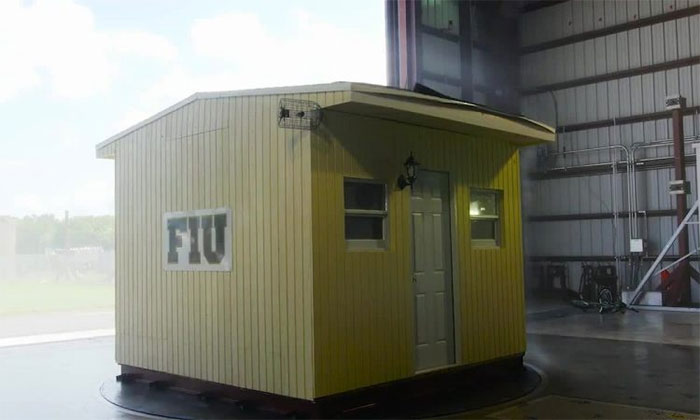The 'wall of wind' can blow the whole house away
The reconstructed "wind wall" at Florida International University allows engineers to test the strength of the building against winds of up to 257km/h.
In an airplane hangar in Miami, engineers reconstructed some of the world's most powerful hurricanes to ever hit land. Category 5 winds could shatter the test house in the blink of an eye.
When engineers built the Wall of Wind test facility 10 years ago at Florida International University, they drew inspiration from Hurricane Andrew, a "monster" hurricane that devastated southern Florida last year. 1992. This facility is designed to test the ability of structures to withstand strong winds up to 257 km/h. However, today stronger storms are appearing more and more often such as Hurricane Dorian, which devastated residential areas in the Bahamas with winds of 296 km/h in 2019 and Hurricane Patricia, with strong winds of 346 km/h, destroying the area. coastal Mexico in 2015.
Studies show that tropical cyclones are increasing in intensity due to climate change as well as higher ocean and atmospheric temperatures. Designing homes and infrastructure to withstand future storms like Dorian requires many new windstorm simulation facilities. Currently, there is only one test facility at Florida International University that is capable of generating Category 5 hurricane winds, the strongest hurricane level on the US classification scale.
On one side of the facility is a curved wall mounted with 12 giant fans, each as tall as an adult. When the fans are combined, the wall can reproduce a 257 km/h storm. The jets simulate rainwater being hit by the wind. The other side of the facility opened onto a large field, where engineers could observe how structures collapsed and debris scattered. Strong storm simulations allow them to learn design and construction weaknesses, track damage throughout the building, and test advanced solutions in conditions close to actual hurricanes. Cameras and sensors record every millisecond as the house, roofing material and many other components remain standing or are blown apart by the wind.
10 years of research at this facility has helped builders and designers reduce the risk of damage. In a destructive test, the team at Florida International University found that, as long as the wind swept through the weakest point, the structure was often damaged in less than a second.

Roofs are susceptible to the effects of lift during storms.
As Hurricane Dorian swept through the Bahamas, many less-than-stable homes turned to rubble, creating another problem. After a house collapses, nearby homes built to withstand higher winds are more susceptible to falling debris. The team's testing shows how debris from a house can hit a nearby house in conditions of continuous wind blowing at 209 - 225 km/h.
The roof is usually the weakest part. Roofs are susceptible to the effects of uplift during storms, so wind hitting the surface of the house needs a way out. When wind blows over an object in its path, it can cause damage. The new design aims to improve the house's ability to withstand strong winds. For example, a hurricane can create whirlwinds that sweep away materials and lift entire roofs. One solution is to use wind turbines along the edge of the roof to disperse wind power and produce energy at the same time. The shape of the house can also create weakness or contribute to deflecting the wind. Most skyscrapers today avoid building sharp corners. Test results show that a trapezoidal or circular edge will help reduce wind pressure on the building.
Experiments conducted by researchers at Florida International University show how high or low installed subsystems such as the metal part between the wall and roof can cause a house to crumble at low winds, even Designed to withstand Category 5 hurricanes.
While engineers gather data through testing, the nature of storms is also gradually changing as the planet warms. Higher temperatures due to increased greenhouse gas emissions from human activity, cause the air to contain more moisture, and the oceans warm to provide more energy for storms. Research shows that increasingly powerful storms that carry more water and move more slowly are ravaging the areas they pass through with winds, surges, flooding and debris. That's why the team at Florida International University is working with eight other universities to design a new facility to test construction in strong winds of 322 km/h, with a storage tank. water to test the impact of 6 m high waves.
Computers can model the results, but the models still need to be tested by actual experiments. By combining the effects of wind, storm surge and rainfall, the team was able to observe how all the interacting components of a storm interact when affecting residents and the built environment.
- The rotating house uses the power of storms to settle on the ground
- A hundred-year-old 'terrible' painting is hidden in the wall of an old house
- 30,000 honey bees nest in the house wall
- The Great Wall could not stop the Mongols
- 10 things not everyone knows about the wind
- The wall of gum is famous in America
- What happens if the wind stops blowing on Earth?
- Baits, wall paint cause blood cancer in young children?
- Stars flutter down the house
- Lam Dong develops wind power
- The mysterious magic of the people on the top of Truong Son
- The 'missing' section of the Great Wall has been revealed after four decades
 'Fine laughs' - Scary and painful torture in ancient times
'Fine laughs' - Scary and painful torture in ancient times The sequence of numbers 142857 of the Egyptian pyramids is known as the strangest number in the world - Why?
The sequence of numbers 142857 of the Egyptian pyramids is known as the strangest number in the world - Why? History of the iron
History of the iron What is alum?
What is alum?